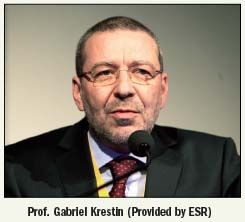Molecular imaging holds promise despite struggle for continued existence
Molecular imaging is hugely expensive, risky, difficult to understand, heavily regulated, without immediate clinical benefit, and not reimbursed.
Molecular imaging is hugely expensive, risky, difficult to understand, heavily regulated, without immediate clinical benefit, and not reimbursed. These factors are halting progress in the field. The solutions for radiology are to collaborate, cooperate, co-own, and cotrain.
That’s the opinion of Prof. Gabriel Krestin, a professor of radiology at the Erasmus Medical Center in Rotterdam, the Netherlands. He addressed this emerging area at an ECR professional challenges session about the radiologist of the future during the March congress.
“Big sharks are waiting out there,” Krestin said, referring to turf battles on the horizon. These battles will be against the powerful, who want to become even more powerful (cardiology, internal medicine, and neurology/neurosciences); the knowledgeable, who know more and do it better (molecular biology and biochemistry); and against the weak, who want to survive (nuclear medicine, neurosurgery).

Radiology must care about molecular imaging (MI) because it represents the future and opens the way for personalized medicine, he said. Furthermore, clinicians will ask for it increasingly often, it boosts imaging research and is a good source of funding, it is sexy, and if radiologists don’t do it, others will.
Krestin noted that surveys have shown the following:
• The main focus of MI is oncology, followed by cardiovascular diseases and technology development (U.S.) or neurosciences (EU).
• There is a positive correlation between the number of radiologists in a department and available MI modalities and funding, and the amount of grants correlates negatively with the number despite struggle for continued existence of exams in the U.S, but this is not the case in the EU.
• Larger research-oriented and wellfunded departments of radiology in the EU tend to participate in enterprisewide MI programs.
• Multidisciplinary teams are characteristic for MI programs, both in the U.S. and the EU.
His short-term recommendations are to create a network of centers of excellence, which could be certified as reference training centers in MI; set up and sponsor workshops and scholarships on MI; guarantee growth of MI topics at major radiology meetings; sponsor young radiologists to attend MI workshops and major MI meetings; and develop collaborations with the other European societies involved in MI (European Association of Nuclear Medicine, European Society for Molecular Imaging) for a common and multidisciplinary approach.
His midterm suggestions are that institutions apply jointly for research grants in MI to develop new applications or new imaging technologies; to set up clinical research grants for development of translational projects or pilot clinical trials in MI; to sponsor training in new hybrid technologies; to build up a webbased collection of teaching materials accessible to ESR members; to raise public and private funds for development of MI in radiology ; and to implement a specific training curriculum for acquiring knowledge in cell and molecular biology, genetics, and MI.
A version of this article appeared in the 2010 ECR Today newspaper.
The Reading Room Podcast: Current Perspectives on the Updated Appropriate Use Criteria for Brain PET
March 18th 2025In a new podcast, Satoshi Minoshima, M.D., Ph.D., and James Williams, Ph.D., share their insights on the recently updated appropriate use criteria for amyloid PET and tau PET in patients with mild cognitive impairment.
Meta-Analysis Shows Merits of AI with CTA Detection of Coronary Artery Stenosis and Calcified Plaque
April 16th 2025Artificial intelligence demonstrated higher AUC, sensitivity, and specificity than radiologists for detecting coronary artery stenosis > 50 percent on computed tomography angiography (CTA), according to a new 17-study meta-analysis.